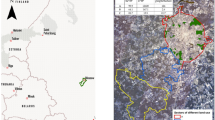Abstract
Based on the GPS coordinates of geobotanical releves seven altitudinal zone association of Tuva forests have been revealed and a set of rasters with climatic and topological parameter values, potential areas of associations has been drawn using the MaxEnt software package. These techniques allowed us to extrapolate fragmentary data on specific locations of association communities to a territory that has not been studied in detail in this respect before. The data on the areas of altitudinal zone associations of forests correspond to real distribution of forests. The analysis of potential areas of these forests has been carried out, the presence of three bioclimatic sectors in Tuva has been confirmed, and their borders have been clarified.




Similar content being viewed by others
REFERENCES
Austin, M.P., Species distribution models and ecological theory: a critical assessment and some possible new approaches, Ecol. Model., 2007, vol. 200, pp. 1–19.
Efimtsev, E.A., Climate essay, in Prirodnye usloviya Tuvinskoi avtonomnoi oblasti (Environmental Conditions of Tuva Autonomous Region), Moscow, 1957, pp. 46–65.
Elith, J. and Leathwick, J.R., Species distribution models: ecological explanation and prediction across space and time, Annu. Rev. Ecol. Evol. Syst., 2009, vol. 40, pp. 677–697.
Elith, J., Phillips, S.J., Hastie, T., Dudik, M., Chee, Y.E., and Yates, C.J., A statistical explanation of MaxEnt for ecologists, Diversity Distrib., 2011, vol. 17, pp. 43–57.
Grinnell, J., The niche-relationships of the California Thrasher, Auk, 1917, vol. 34, pp. 427–433.
Guisan, A. and Zimmerman, N.E., Predictive habitat distribution models in ecology, Ecol. Model., 2000, vol. 135, pp. 147–186.
Guisan, A., Zimmermann, N.E., Elith, J., Graham, C.H., Phillips, S., and Peterson, A.T., What matters for predicting the occurrences of trees: techniques, data, or species’ characteristics? Ecol. Monogr., 2007, vol. 77, pp. 615–630.
Guo, Q. and Liu, Y., ModEco: an integrated software package for ecological niche modeling, Ecography, 2010, vol. 33, pp. 1–6.
Korolyuk, A.Yu., Lebedeva, M.V., Sandanov, D.V., and Otmakhov, Yu.S., Climate modeling of areas of steppe communities in West Siberia and the South Urals, Materialy Pyatnadtsatoi mezhdunarodnoi nauchno-prakticheskoi konferentsii “Problemy botaniki Yuzhnoi Sibiri i Mongolii” (Proc. Fifteenth Int. Sci.-Pract. Conf. “Botany of Southern Siberia and Mongolia”), Barnaul, 2016, pp. 83–86.
Makunina, N.I., Botanical and geographical characteristics of forest steppe of the Altai-Sayan mountain region, Contemp. Probl. Ecol., 2016, vol. 9, no. 3, pp. 342–348.
Makunina, N.I., The forests of Tuva: classification and geobotanical review, Rastit. Mir Aziat. Ross., 2020, no. 1 (37), pp. 40–78.
Phillips, S.J. and Dudik, M., Modeling of species distributions with MaxEnt: new extensions and a comprehensive evaluation, Ecography, 2008, vol. 31, pp. 161–175.
Phillips, S.J., Anderson, R.P., and Schapire, R.E., Maximum entropy modeling of species geographic distributions, Ecol. Model., 2006, vol. 190, nos. 3–4, pp. 231–259.
Polikarpov, N.P., Chebakova, N.M., and Nazimova, D.I., Klimat i gornye lesa Yuzhnoi Sibiri (Climate and Mountain Forests of Southern Siberia), Novosibirsk, 1986.
Stigall, A.L., Using ecological niche modeling to evaluate niche stability in deep time, J. Biogeogr., 2012, vol. 39, pp. 772–781.
Stockwell, D.R.B. and Peters, D.P., The GARP modeling system: problems and solutions to automated spatial prediction, Int. J. Geogr. Inf. Syst., 1999, vol. 13, pp. 143–158.
Funding
This work was carried out as part of the state assignment of the Central Siberian Botanical Garden, Siberian Branch, Russian Academy of Sciences (state registration number AAAA-A17-117012610052-2), as well as with partial financial support from the Russian Foundation for Basic Research (project no. 18-04-00822).
Author information
Authors and Affiliations
Corresponding author
Ethics declarations
Conflict of interests. The authors declare that they have no conflicts of interest.
Statement on the welfare of humans or animals. This article does not contain any studies involving animals performed by any of the authors.
Rights and permissions
About this article
Cite this article
Makunina, N.I., Egorova, A.V. & Pisarenko, O.Y. Drawing of Potential Areas of Plant Communities for Geobotanical Zoning Purposes (on Example of Tuva Forests). Contemp. Probl. Ecol. 13, 412–417 (2020). https://doi.org/10.1134/S1995425520040095
Received:
Revised:
Accepted:
Published:
Issue Date:
DOI: https://doi.org/10.1134/S1995425520040095




